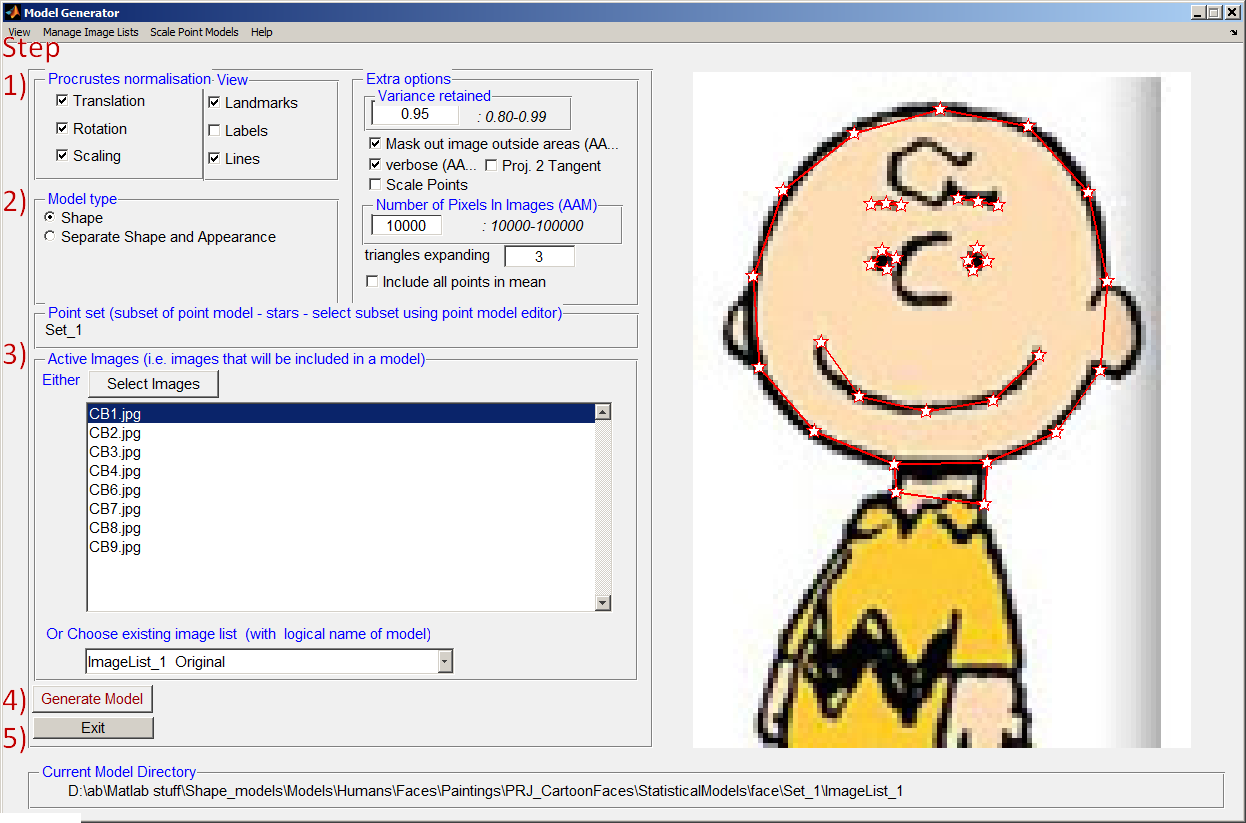AAMToolbox statistical model generator: Difference between revisions
Jump to navigation
Jump to search
No edit summary |
No edit summary |
||
| Line 10: | Line 10: | ||
===Step 1) Options=== | ===Step 1) Options=== | ||
[[File:Stats_Model_Options_AAMToolbox.png|500px|The Model generator control panel]]<br><br> | [[File:Stats_Model_Options_AAMToolbox.png|500px|The Model generator control panel]]<br><br> | ||
* | *The first step in PCA is to align all the point models. In this case we assume that the images should be normalised to the''' same scale, same rotation and same translational''' position. This might not always be the case. If we want to model leaf growth then the point model should '''not''' be scaled. Alternatively, if we want to capture the pose of a face portrait the point models should not be rotationally aligned.<br> | ||
For the '''cartoon faces we normalise for all three'''. | |||
===Step 2) Type of model=== | ===Step 2) Type of model=== | ||
In this case the statistical '''Shape''' model will be generated from the point models alone. In other cases, we might want to include the image colours, pixel by pixel, in the PCA in which case we create two models '''Shape and Appearance''' (AAM). | |||
**If AAM then | **If AAM then | ||
***Select whether to mask out the image not within the a boundary set by the outermost landmark points | ***Select whether to mask out the image not within the a boundary set by the outermost landmark points | ||
***Select the number of pixels to be used when forming the mean image intensity (appearance). | ***Select the number of pixels to be used when forming the mean image intensity (appearance). | ||
**If modelling a subset of landmark points | **'''Point set'''. The AAMToolbox supports the concept of point model 'sets'. In other words, subsets of landmarks can be grouped together into a set. Set_1 is always all the points. The points that are currently selected are shown as stars. Here, all the points are selected. The options are discussed in the Tutorial on 'sets'. | ||
**If modelling a subset of landmark points it can be useful to place the model at the mean position of all the landmarks. This can be selected by ticking 'include all points in mean'. (A subset of landmark points is selected in the AAMToolbox:Point Model Editor.) | |||
===Step 3) Point models and images to contribute to the model | ===Step 3) Point models and images to contribute to the model | ||
*'''Select the image point models''' you want to include. Usually all of them. | *'''Select the image point models''' you want to include. Usually all of them. | ||
| Line 24: | Line 26: | ||
===Step 5) Exit=== | ===Step 5) Exit=== | ||
*The next step is to view results from the model, AAMToolbox: '''View Stats Mode''' | *The next step is to view results from the model, AAMToolbox: '''View Stats Mode''' | ||
Revision as of 13:40, 13 February 2012
Statistical shape generator (PCA)
Generate a new PCA model from the AAMToolbox control panel
From the AAMToolbox workflow control panel elect Stats Model Generator:
Statistical Model Generator control panel.
Showing the steps (in red) to build a statistical model.

Steps to build a shape model using principle component analysis (PCA)
Step 1) Options
- The first step in PCA is to align all the point models. In this case we assume that the images should be normalised to the same scale, same rotation and same translational position. This might not always be the case. If we want to model leaf growth then the point model should not be scaled. Alternatively, if we want to capture the pose of a face portrait the point models should not be rotationally aligned.
For the cartoon faces we normalise for all three.
Step 2) Type of model
In this case the statistical Shape model will be generated from the point models alone. In other cases, we might want to include the image colours, pixel by pixel, in the PCA in which case we create two models Shape and Appearance (AAM).
- If AAM then
- Select whether to mask out the image not within the a boundary set by the outermost landmark points
- Select the number of pixels to be used when forming the mean image intensity (appearance).
- Point set. The AAMToolbox supports the concept of point model 'sets'. In other words, subsets of landmarks can be grouped together into a set. Set_1 is always all the points. The points that are currently selected are shown as stars. Here, all the points are selected. The options are discussed in the Tutorial on 'sets'.
- If modelling a subset of landmark points it can be useful to place the model at the mean position of all the landmarks. This can be selected by ticking 'include all points in mean'. (A subset of landmark points is selected in the AAMToolbox:Point Model Editor.)
- If AAM then
===Step 3) Point models and images to contribute to the model
- Select the image point models you want to include. Usually all of them.
- You will invited to give a name to the model you are about to compute
Step 4) Generate Model
Step 5) Exit
- The next step is to view results from the model, AAMToolbox: View Stats Mode

